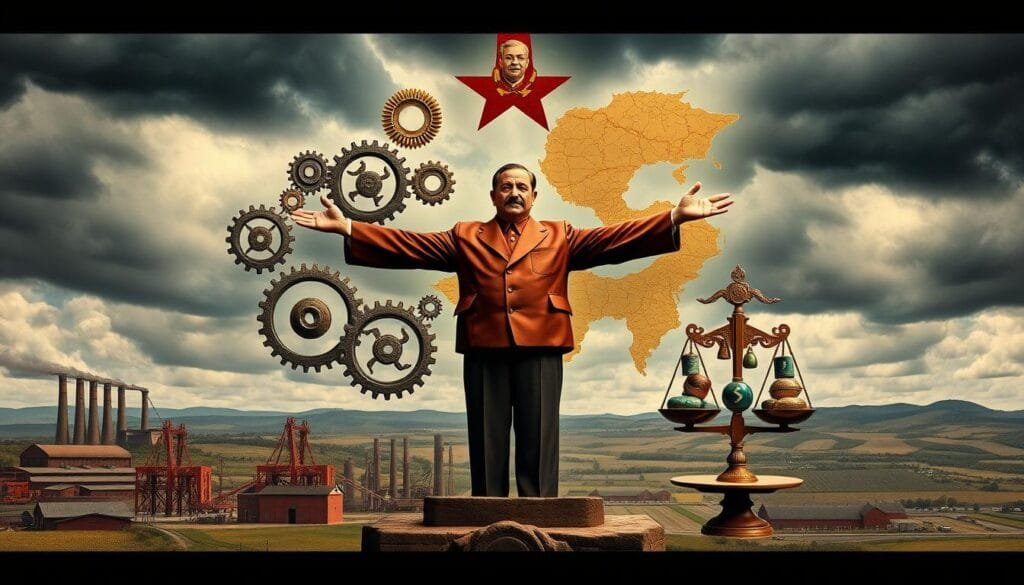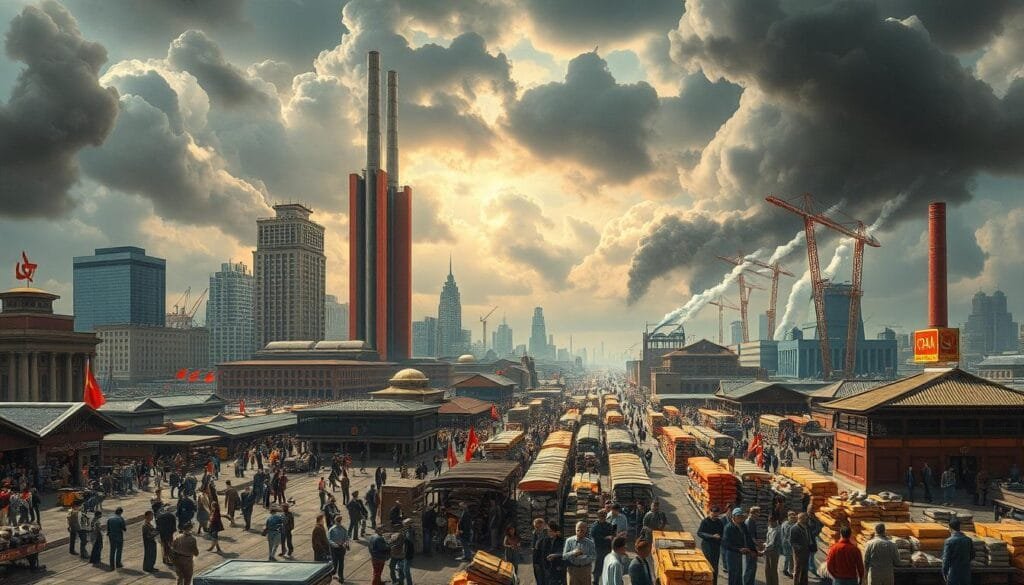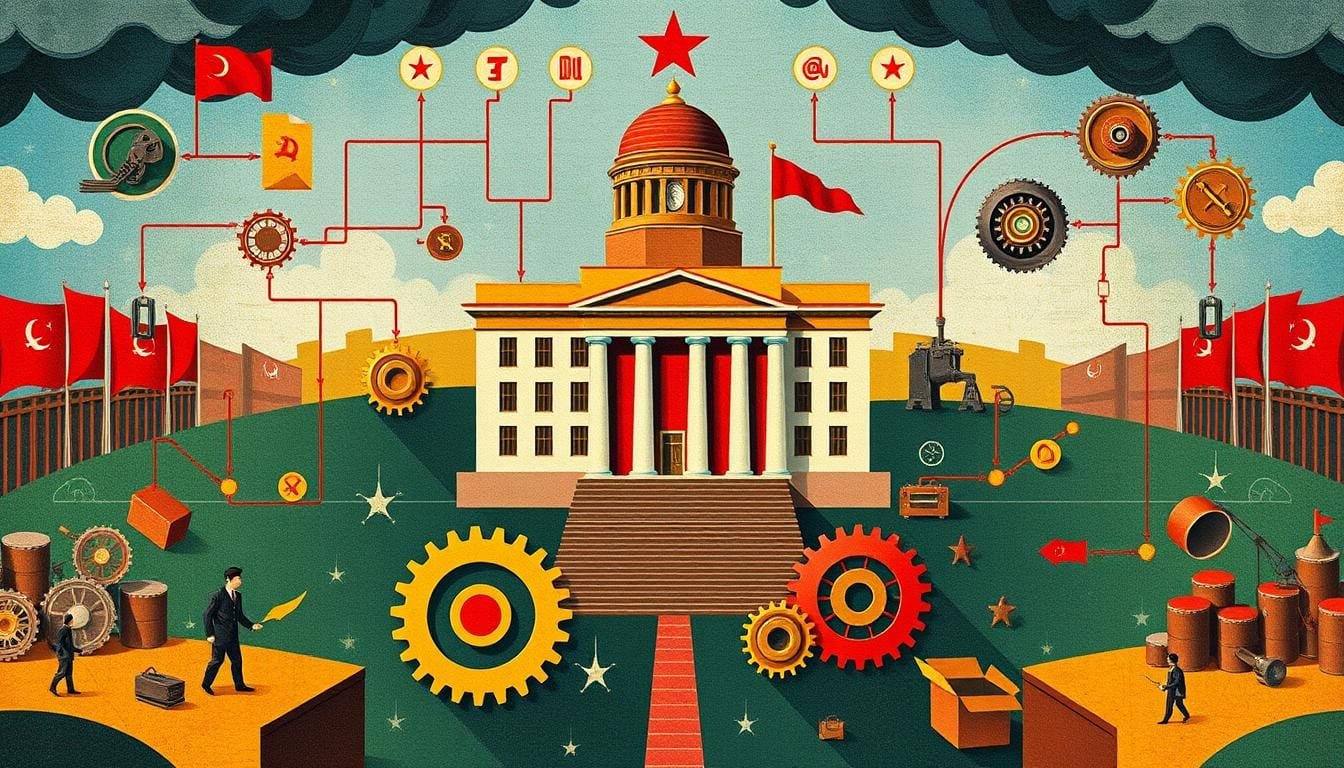In our journey through global economic frameworks, we find various systems that shape how societies work and succeed. The command economy is notable for its unique take on government control, guiding economic policy, and handling of resources. This model is defined by substantial government power over all economic activity. The government decides what to produce, how to produce it, and who should receive the products. History shows us examples from Ancient Egypt to countries like North Korea today. This is a clear contrast to the decentralized approach of free markets, such as in the United States.
In a command economy, the focus is on how to distribute resources and manage the economy to meet societal goals. Goals that often differ greatly from those in market-driven systems. Experts in the field, like Chiara Yates at Southern New Hampshire University, investigate these aspects. They look into the system’s strengths and weaknesses in great detail. Their research helps shape policies, business strategies, and government decisions all over the world.
We go deep into command economics to get a full picture, beyond just the basic definitions. We concentrate on how control mechanisms shape societies with command economies. Our aim is to understand their structure and growth.
Key Takeaways
- Command economy entails centralized government control of all economic activity, including resource allocation.
- Distinguished by government decision-making, command economies stand in contrast to market economies where individual choices drive economic outcomes.
- Historical and contemporary examples, ranging from Ancient Egypt to North Korea, offer insights into the workings of command economic systems.
- Under a command economy, economic efficiency, freedom, and growth are seen through the lens of government priorities rather than market forces.
- Economists like Chiara Yates study the command economic system to understand the allocation of scarce resources and the impact on societal development.
- Understanding the command economy illuminates the broader spectrum of global economic systems and their respective approaches to managing production and distribution.
Understanding Command Economics
Command economies stand out sharply from other types. Examples are found in the past Soviet Union and today’s Cuba and Venezuela. These economies are shaped by strong government control and central planning.
The Basics of Command Economy
In command economies, the government has the final say on production and distribution. This system believes a single authority can address resource scarcity. It sets economic goals differently from market economies, where supply and demand control prices.
Prices in these economies are not market-driven but set by planners. This approach decides the type and amount of products made. It changes how consumer choice works compared to freer economies.
Comparing Economies: Market, Mixed, and Command
The United States is mainly a market economy with private ownership and profit goals. Yet, it also has government regulation, showing traits of a mixed economy. But in command economies, the state controls everything, leaving no room for competition or private ownership.
Mixed economies blend free economic choices with some government control. This setup works well in emergencies or wars, unlike the rigid market economies.
The Role of Government in Command Economies
The government’s role in command economies is crucial. It decides what needs producing and where resources go. This helps address scarcity but can hinder efficiency and innovation.
Such planning lets the government move resources quickly. However, critics like Ludwig von Mises and F.A. Hayek see flaws in stifling consumer choice. Despite its mobilization advantages, command economies face criticism.
For more insights into economic systems, check out command, market, and mixed economic systems. Command economies are notable for government control and a distinct stance on resource scarcity. They aim to meet national goals but often limit economic variety and personal choice.
How Do Command Economics Answer The 3 Questions How
In a command economy, the government decides how to manage resources, what goods and services to produce, and who gets them. Decision making is central, looking at economic trade-offs under resource limits. Unlike market economies, command systems judge needs and set aims without market signals.

The government picks how to distribute resources to decrease scarcity impact. In places like the former Soviet Union or North Korea, it controls production and distribution. It aims at big goals like job stability or becoming industrialized, not market wants.
Command economies also face choices, like spending more on health or on roads. These decisions shape how well the economy meets its people’s needs. By steering pricing and how much to make, these economies aim to push societal progress. Yet, they might limit personal freedom and creativity.
Critics say command economies lack in innovation and efficiency because they don’t motivate people enough. Yet, supporters see their strength in managing big projects or crises quickly. For example, industrial growth in Stalin’s era or China’s advancement after 1978 show this ability.
How command economies decide on resource use and face scarcity creates unique challenges. These deeply affect their growth and how they work out economic puzzles.
Key Features and Principles of Command Economics
Command economies are built on centralized planning and economic authority. Governments take control over vital economic activities. Around the world, these economies vary widely. They adapt to each country’s unique political and economic situation.
Government Decision Making in Economic Activities
In these economies, the government holds all economic power. It makes every significant decision about production and distribution. This approach ensures that government goals for the economy are achieved. It focuses on production efficiency. However, it might limit personal business initiatives and market innovation.
Allocation of Resources and Production Control
Command economies manage resources to meet national goals. The government decides how to distribute resources to ensure fair access across different areas. This can lead to more equal distribution. Yet, it often faces issues like slow bureaucratic processes and possible mismanagement.
Advantages and Challenges of a Command Economic System
A command economy can quickly mobilize for big projects, which is a plus. This ability can help a country achieve important goals more efficiently. On the downside, ignoring market demands can lead to too much or too little product availability. This problem shows the difficulty of estimating what people really need or want.
- Speed advantage: Planned economies can swiftly engage resources to execute massive infrastructure or social projects.
- Unity benefit: These economies can enact rapid transformations to align societies with a common governmental vision.
- Ignoring consumer preferences: The focus on government agendas can overlook actual market demands, causing imbalances.
- Discouraged innovation: The stringent adherence to set plans can stifle creativity and deter private sector innovation.

Below, we can see how different countries apply command economics. They are influenced by their history, society, and economy.
| Country | Control Level | Economic Characteristics |
|---|---|---|
| North Korea | High | Centralized control, severe economic restrictions, facing humanitarian issues. |
| China | Moderate to High | Transitioning with market reforms, still retaining significant government planning. |
| Cuba | Moderate | Incorporating market strategies to revitalize the economy post-Soviet support. |
| Libya | Moderate | Dominantly state-run, heavily reliant on oil and governmental sectors. |
Different countries show us the adaptability of command economies. They highlight how this system can adjust to both worldwide changes and national needs.
The Impact of Command Economics on Society
Command economics is key in shaping societal outcomes. It touches everything from government policy to economic impact. Countries using this model focus on public welfare, but the effects vary across different areas.
Let’s look at how command economics affects societies around the world. China changed its approach to agriculture. They mixed command systems with market ideas, leading to growth. From 1978 to 1984, agricultural output jumped by 42%.
But in North Korea, tight controls remained. Even so, slight reforms started changing their economy. The rise of farmers’ markets shows these changes.
| Country | Policy Change | Result |
|---|---|---|
| China | Partial adoption of market principles in agriculture | 42% increase in agricultural output |
| North Korea | Introduction of farmers’ markets despite strict controls | Emergence of new market dynamics |
In the US, a different economic system led to big spending on social services in 2011. They spent over $2 trillion, 13.5% of its GDP. This money supported various programs to help citizens.
Cuba offers another example. Despite strict controls, about 95% of people take part in an underground economy. This shows how people find ways to meet their needs, despite government restrictions.

In command economies, you often see less inequality and unemployment. This is because the government has control over jobs and pay. But, this also means less competition, which can slow down innovation and efficiency.
Countries like Cuba focus on public services, like health care for all. This shows their dedication to public welfare. Still, some believe these economies are slow to innovate compared to those encouraging competition.
Moving to a market-based economy can lead to better products, prices, and efficiency. Command economies play a big role in societies and individuals’ lives. Yet, outcomes greatly depend on how well they blend with market practices.
Looking at command economics globally, we see a mixture of government control and social adaptation. Each country’s story highlights the balance between policy and welfare. This creates a wide array of effects on economies and daily lives.
Conclusion
We have discussed how command economies tackle key economic issues, such as what and how to produce, and for whom. These economies rely on central government plans, unlike those driven by market forces. We looked at various examples, from the Soviet Union’s past to present-day North Korea and Cuba.
We compared these to market economies in places like the United States and Japan. These places let the market and consumers guide production and distribution. We also explored traditional economies in developing countries, showcasing their resilience. These examples show how vital proper resource use is for any economy’s success.
The way we manage economies is changing. Developed nations mix command and market economies to try for the best of both worlds. They seek a balance between freedom and equality. Yet, maintaining this balance can be hard, especially when governments overreach. Economists and academic places like SNHU play a key role. They analyze trends and help guide policy. Our economic future depends on understanding and innovating within these systems.
FAQ
What is a command economy?
A command economy is when the government controls all economic stuff. This includes how resources are shared, what things are made, and who gets them. The government decides everything about the economy.
How does a command economy compare to market and mixed economies?
In a market economy, decisions are based on what people buy and sell with little government input. Mixed economies have both government and market influence. But, in a command economy, the government makes all the decisions.
What role does the government play in a command economy?
The government has a big job in a command economy. It decides on how resources are used and what goods are made. Their decisions aim to solve issues like scarcity and meet the country’s needs.
How are resources used and allocated in a command economy?
In a command economy, the government picks how to use resources. It decides what’s important based on goals and scarcity. This is different from market economies, where prices help decide how resources are used.
What are some advantages and challenges of a command economic system?
Command economies can focus resources well and make big changes quickly. But, they can be inefficient and limit freedom. They might not meet people’s needs well and can stifle new ideas.
How does command economics impact societal outcomes and public welfare?
Command economics can really shape society. It can boost industries and help meet national goals. But, it might also limit people’s choices and ignore some areas.
What are the economic trade-offs in a command economy?
In a command economy, the government has to pick what to focus on. This means some areas might get lots of resources while others get less. Choices like these can affect what goods are available.
What factors contribute to a government’s decision-making process in a command economy?
When a government makes decisions in a command economy, it thinks about what’s scarce, its big plans, politics, and societal needs. It tries to balance these to guide the country’s growth.
How does command economics deal with scarcities and externalities?
Command economics uses government plans to handle scarcities and externalities. It might focus resources on important industries or make laws to deal with problems like pollution.
Why do some modern economies blend command and market economic systems?
Some economies mix command and market systems to get the best of both. This way, they can enjoy market efficiency and innovation while the government steps in to fix market problems and support fairness and public services.
